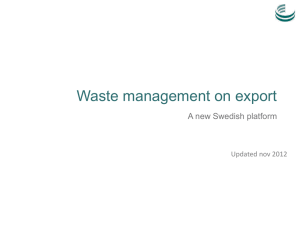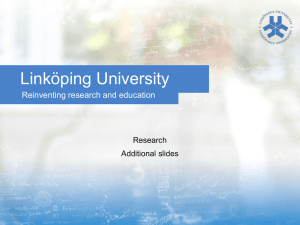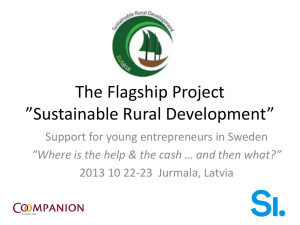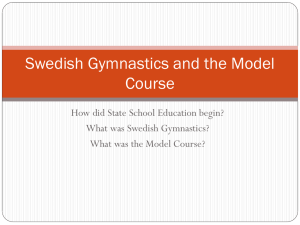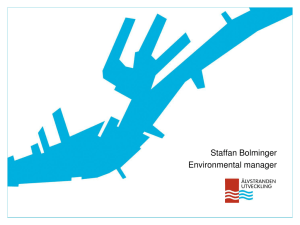The races of the Teutonic peoples - Anthropology from a World that
advertisement
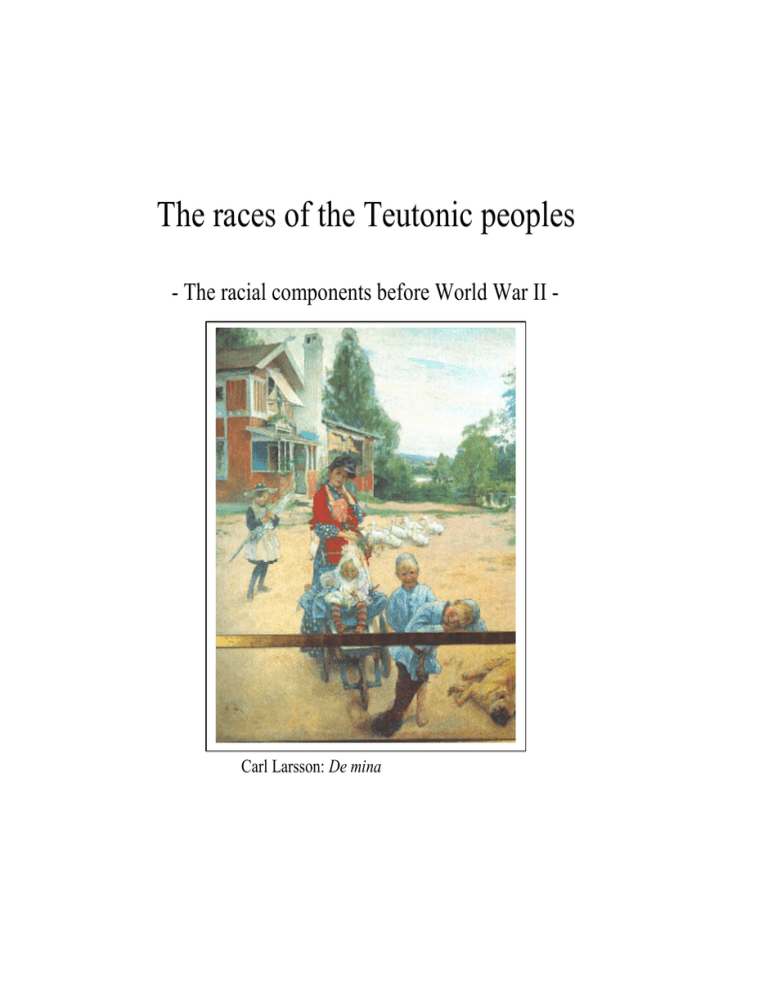
The races of the Teutonic peoples - The racial components before World War II - Carl Larsson: De mina Why do I do this? At first I would like to point out that this work is not a political statement, I have absolutely no desire to prove anything from a political point of view. I will rather try to describe the reality as it is, and not how I or anybody else would like it to be. To answer the question why: I do it out of curiosity, and that at least as far as I know, a work like this has never been done before. I also believe that a work like this will answer some unanswered questions about our European heritage. 1. Method Basically I will use every kind of conventional race characteristics that have been defined and measured. In other words I will use both: - Older physical race traits, as pigmentation, stature, head form, face form, noose form etc. 1 - Newer race traits as blood-, serum- and enzyme groups. 2 I also assume that the reader is familiar with the basics of anthropology and its applications. Furthermore, and as the reader probably will discover, the work will focus a little bit more on Scandinavia and particularly my own country Sweden. 1 2 See Appendix I See Appendix II 2 2. Definitions Race I define a race as an ideal type 3 consisting of a specified genetic structure that gives it typical, and from other races distinguished, physical and mental characteristics. I assume that following races have left traces in the Teutonic peoples: The Old Atlantic race 4 The Alpine race The Nordic race The North Atlantic race The (West) Mediterranean race [Caucasians] The Dinaric race The East Baltic race The Lappoid race 3 4 In this case I refer to Max Weber’s Ideal type. Bryn and Lundman assume that this race is an old remain of the first Cro Magnon-like Western Europeans. 3 Teutonic To be regarded as a Teuton I assume that one must match one of the following two conditions: 1. A Teutonic language as mother tongue. Consider one to belong to an ethnic group that direct or indirect has its origin in the ‘Teutonic original home’ 5 2. A Teutonic language as mother tongue. Consider oneself to belong to a geographical well defined group that consider itself to culturally belong to an ethnic group that direct or indirect has its origin in the ‘Teutonic original home’. In this category we may for example find the former Celtic peoples of western England, the former Sorbic areas of Brandenburg and Sachsen, the former Baltic areas of Prussia and the former Lappic and Finnic areas of the northernmost parts of Scandinavia. 5 I assume the Teutonic original home to be equal to the area that was covered by the late Nordic Bronze Age. 4 The peoples that match my definitions of Teutonic peoples are: Norsemen Icelanders Faeroese The population of the Shetland - and the Orkney islands Norwegians Swedes Danes Eastern Teutons 6 Teutons Western Teutons Germans Dutchmen Flemings Friesians Englishmen, excluding the Cornish 7 Lowland Scots The Protestants of Northern Ireland The English-speaking population on the Channel Islands. 6 Among the Eastern Teutonic peoples we for example find the Vandals (7th century), the Visi Goths (10th Century), the Ostro Goths (7th century), the Crimea Goths (18th century) and the Burgunds (7th century). 7 Although the last Cornish speaking person, Dolly Pentreath, died in 1777, about 85 % of the place names in Cornwall is of Celtic origin. Furthermore the people of Cornwall are still aware of their Celtic heritage, and in the magazine Cornish Life John Page describes it as: Cornwall is not an English county…A crossing of the Tamar is as much the crossing of a border as is a journey into Scotland or Wales, and the Cornish want this fact recognised…we want road signs and public notices in our own Language: we want that language used in official functions. 5 4. The distribution of the races 4.1 The Nordic race The Nordic Race has its strongest positions in the parts of the Teutonic original home that wasn’t covered by Slavic settlements during the early medieval times. Furthermore it’s also strong in areas that were reached by Scandinavian settlers from the 14th century and forward on. Finally it’s also evident in the parts of Britain that were settled by the Anglo-Saxons and the Vikings. The general picture is otherwise that the influx of the Nordic race becomes weaker the more to the east and to the south we go. There have also been some attempts to estimate the relative strength of of the Nordic Race in some countries and areas. Following estimations have been made: a. Günther: Northern Germany : 65-70 % Southern Germany : 45-50 % Austria : 30-35 % Switzerland : 30 % (Predominant in the Hasli Valley) The Brittish Isles : 55-60 % b. Ploetz: France : 25 % The Iberian Penisula : 15 % c. My estimations: The Finland Swedes : 45-50 % The Estonia Swedes : 45-50 % The Finns : 15-20 % The Swedish Saamis : 12 % The Tornedalians 8 : 20 % d. Society for Nordic Physical Anthropology: Poland : 5% Bulgaria : 5% Greece : 5% 8 The Tornedalians are a finnish speaking minority in the Torne River Valley in northeastern Sweden 6 4.2 The Old Atlantic race Based of what we so far know, the North Atlantid race seams to be the oldest, still existing, European race. Today it’s purest in some remote parts of Scandinavia (Dalarna and Trøndelag) and the Brittish Isles (eastern Ireland). It’s also probably, to some degree, spread all over Europe, and locally it may even be in majority in some remote parts of the continent. According to Nordenstreng it’s for example evident among the Sudeten Germans in Egerland. 4.3 The East Baltic race The East Baltic race is basically found in the following three areas of the Teutonic range: The former Slavic parts of eastern Germany The border areas between Scandinavians and Finnic-/Baltic peoples were it has oozed in during the tale of history. Areas in central Scandinavia those were colonized by Savolaxian settlers in the late 16th and early 17th centuries. There have also been some attempts to estimate the relative strength of of the East Baltic Race in some countries and areas. Following estimations have been made: a. Günther: Eastern Germany Western Germany b. My estimations: The Indegenous Swedes The Finland Swedes The Estonia Swedes The Finns The Swedish Saamis The Tornedalians : : 15 % 3- 4 % : 5- 6 % : 45-50 % : 50-55 % : 60-70 % : 42 % : 60 % 7 4.4 The Lappoid race The influx of the Lappoid race is rather sparse, and it’s also basically limited to the ScandinavianSamic border areas. According to my estimations the relative strength of the Lappoid race is as follows: The Indegenous Swedes The Norwegians The Icelanders The Finland Swedes The Finns The Swedish Saamis The Tornedalians 4.5 : 1- 2 % : 3- 4 % : 1- 2 % : 5% : 10-15 % : 46 % : 20 % The Dinaric race Except for the fact that it has oozed into Austria and Eastern Germany from the Balkans and southeast Europe, it has also – via Switzerland – been established in Burgund and in Alcase. The sparse influx among the North Sea has probably another immigration history, and may have its origin in amber seekers during the Bronze Age. The following estimations of its relative strength have been made: a. Günther: Northern Germany : 5% Southern Germany : 20 % b. My estimates based on the results from Society for Nordic Physical Anthropology: Germany : 10-15 % Austria : 35-40 % Switzerland : 30 % 8 4.6 The Alpine race Despite its name, the Alpine race holds its strongest possessions in Massif Central, and not in the Alpine region. In the Teutonic area it’s as strongest in (probably more than 50%) in the German speaking parts of Switzerland and in Southern Germany, particullary in the Bayrischer Wald. It is also evident in the Mitteldeutsches Bergland and among the shores of the river Elbe. The Alpine influx in western Norway is more diffucult to get a grip on. There have been a number of theories about its heritage, and some of them are: - It’s an old reamain of a population that lived there during the Ice Age. - It came in as a separate immigration wave during the Stone Age, and it has in that case, also left genetical traces in the Saamis. - It’s a midgeted and brachyphilizied variant of the Old Atlantic race - It came in with the Rugian (Rogaland and Ryfylke) re-immigration during the era of the great Teutonic migrations. The following estimations of its relative strength have been made: a. Günther: Northern Germany : 13 % Southern Germany : 20 % (It seems to be an unlikely low estimation, see the maps) The Brittish Isles : 10 % (This figure may probably also include Old Atlantic influx) b. Ploetz: France : 50 % The Iberian Penisula : 15 % c. My estimates based on the results from Society for Nordic Physical Anthropology: Germany : 25-30 % Austria : 35-40 % Switzerland : 30 % 9 4.7 The Mediterranean race In the area of the Teutons the Mediterrian race has three, rather scattered, strongholds: - South Tirol - Western Switzerland and the Rhine Valley, partly as a result of the Hugenott immigration during the 17th century. - The Brittish Isles, where it’s assumed to be an old remain of its iberian-, pre-celtic and preteutonic, settlements. The following estimations of its relative strength have been made: a. Günther: Germany : 2% The Brittish Isles : 30 % (Problably a too high estimate, see below) b. Ploetz: France : 25 % The Iberian Penisula : 70 % c. My estimates based on the results from Society for Nordic Physical Anthropology: England : 10-15 % Scotland : 10-15 % Wales : 30 % 9 Ireland : 25-30 % Iceland and Norway : 1- 2 % 4.8 The North Atlantic race Perhaps the North Atlantic ancestors were the Megalith builders.If these Megalith builders originally were fair-haired, and then their descendants slowly have become dark-haired on the Brittish isles. On the other hand, if the Megalith builders’ origanally were dark-haired, then their descendants have become fair-haired in Friesland, Jylland and southeast Scandinavia, and kept their dark hairness on the Brittish Isles. Notable is also that this area, northwestern Europe, has the highest rates of red hair and clear blue eyes in the whole world. From the Brittish Isles the race has, bacically through thrall import, been spread to the Atlantic islands and also into western Norway. The relative strong North Atlantic influx in the Flanders is a little bit harder to explain, perhaps it also is due to descendants from the Megalith builders, or can it instead be a stabilized NordicMediterrian mixture? 9 In Newquay on the Welch western coast 83,2% of the indigenous populationon is dark haired and dark eyed 10 4.9 Other races There are also some very small and scatterd influxes of other races. Among these we find: The Wolgid race (basically via the Finns) The West Siberian race (via the Saamis, the Finns and the Tatars) The Indide and Weddid races (via the Gypsies) The Anatolian race (via the Jews and the Armenians) The Arabid and perhaps also African Sudanid (via roman mercenaries), the question on African genes in the Northern European populations is still under heavy debate, though. 11 The Teutonic peoples 1937 12 13 14 15 16 17 18 19 20 Appendix I Skin colour: Rosy Pale Nordic Light Brown Olive Brown North Atlantic Alpine East Baltic Old Atlantic Lappoid Mediterrian Dinaric Eye colour: Blue Grey Light mixed Dark mixed Nordic North Atlantic East Baltic Brown Old Atlantic Lappoid Alpine Mediterrian Dinaric Hair colour: Flaxen Light brown Red Nordic East Baltic Brown Brownish black Black Old Atlantic Alpine Mediterrian North Atlantic Lappoid Dinaric Shape of the body hair: Head hair: Pubic hair: Soft Medium Abundant Mediterrian Dinaric Old Atlantic Medium Nordic North Atlantic Sparse Rough Alpine East Baltic Lappoid 21 Body structure: Stature (20 year old men 1990): Body Shape: 160 cm Slim 170 cm 180 cm Lappoid North Atlantic Nordic, Dinaric Mediterrian Athletic Old Atlantic Square Built East Baltic Alpine Corpulent Head form: Cephalic index: High-length index: 76 78 80 82 84 86 88 70 72 74 North Atlantic Old Atlantic Nordic (West)Mediterrian a North Lappoid East Baltic Alpine 76 South Lappoid 78 80 a Dinaric Although there is an eastern variant of the Mediterrian race as well, I assume that this eastern variant is not mixtured with any Teutonic people. As the reader also can see there are basically two kind of lappoid races, and traces can be found both in the northern Norwegians, where the Northern variant has left traces in the coastal population of Finnmark Fylke. 22 Facial structure: Facial index: Facial form: 82 84 86 88 90 92 Square East Baltic Round Alpine North Lappoid Old Atlantic Eliptic Mediterrian Nordic North Atlantic Oval South Lappoid Dinaric Triangular Noose form: High Convex Straight Dinaric North Atlantic Nordic Concave Old Atlantic Medium Mediterrian Lappoid Short Alpine East Baltic 23 Psychological characters: These characters are, as far as I know, not verified by any scientifical method and/or observation. The psychological idealistic types in the models below are rather based on general observations made by some European pre-WW II anthropologists. Inner personality: Tenacious East Baltic Lappoid, Nordic Old Atlantic Dinaric Choleric Alpine Restrained Mediterrian Flexible 24 Personality towards the surroundings: Profane Nordic Dinaric Old Atlantic Collectivistic Individualistic East Baltic Alpine Lappoid Mediterrian Spiritual 25 Appendix II Genetic distances between some European peoples (Cavalli-Sforza et al & Nevanlinna et al): 18 Norwegians 85 Finns Swedes 37 English 110 39 41 Dutch 16 Russians Germans 32 82 38 47 French Poles 34 44 25 Hungarians 61 Italians Portuguese 77 Greeks One of the outliers, the Lapps, has following genetic distances towards some selected peoples: Norwegians Swedes Finns Russians : 317 : 333 : 210 : 323 Portuguese Germans Italians Greeks : 324 : 314 : 339 : 308 Obvious there is no clear correlation between the physical race traits and genetical markers. The most probable reason may be that physical race traits are of a newer date than the genetical markers. Nevertheless it seems that the genetical markers can give us a rather good distinction between east (Slavs and Finno-Ugrians) and west (Teutons and Latin peoples). It is harder to find 26 any clear distinction between north and south, and the outlier, the Lappoid race, can hardly be placed nor on a east-west nor on a north-south scale. In the model below I have tried to place the races in a geographical context. North Lappoid North Atlantic Nordic West East Baltic Alpine East Dinaric Mediterrian South It seems like it is possible to distinguish the East Baltic and the Lappoid races by using these newer race traits. It is harder to find any clear boundaries between the other races, and I will therefore basically use the newer race traits to calculate influx by the East Baltic or the Lappoid race. On this stage I have no possibility to distinguish the Old Atlantic race from the other western races, except from the fact that it seems to have a rather low share of the eastern blood allele-marker q. According to Lundman there are a western respectively an eastern variant of the Alpine and the Mediterrian races. Why is that? a. The eastern and the western may have different origin, and their physical resemblance is a result of that they have been developed under the same conditions. b. Each kernel of the different groups have the same origin, but they have been mixture with peoples that have very distinct west respectively east genotypes. 27 Appendix III. The Teutonic Peoples in Europe in the year 2000: + : Good opportunities to survive as an ethno-cultural group. o : Unclear status - : Bad opportunities to survive as an ethno-cultural group. Lowland Scots Settlements, remains of settlements and descendants from settlements from before 1939: Scotland : about 2 500 000 + England : about 300-500 000 o Englishmen Settlements, remains of settlements and descendants from settlements from before 1939: England : about 41 000 000 (perhaps 15 % are part-irish, part-welch or part-scottish)+ Scotland : about 250 000 o Northern Ireland Protestants Settlements, remains of settlements and descendants from settlements from before 1939: Northern Ireland : about 900 000 + England : about 150 000 o Scotland : about 15 000 o Channel Islanders Settlements, remains of settlements and descendants from settlements from before 1939: Channel Islands : about 25 000 o Friesians Settlements, remains of settlements and descendants from settlements from before 1939: The Netherlands, West Friesians : about 350 000 + Denmark, North Friesians : about 1 000 Germany, North Friesians : about 9 000 o East Friesians : about 2 000 - 28 Dutch / Flemings Settlements, remains of settlements and descendants from settlements from before 1939: The Netherlands : about 14 750 000 o Belgium : about 5 000 000 + France : about 150 000 + Settlements after WWII: Denmark : about 26 000 o Luxembourg : about 8 000 + France : about 90 000 Germany : about 100 000 o Norway : about 5 000 Spain : about 19 000 o Sweden : about 5 000 Switzerland : about 12 000 o UK : about 39 000 Germans Settlements, remains of settlements and descendants from settlements from before 1939: Germany : about 74 000 000 + Austria : 7 190 000 + Switzerland : 4 670 000 + Liechtenstein : 34 000 + Denmark : 10 000 o Belgium : about 120 000 + Luxembourg : 285 000 + France (Alcasse and Lorraine) : 1 520 000 + Italy, South Tyrol : 310 000 + Veneto : 4 000 o Val d’Osta : 1 000 o Mocheno : 2 000 Romania, Transylvania : 38 000 Other districts : about 25 000 Moldavia : about 7 000 Former Yugoslavia : about 10 000 Hungary : 249 000 + Slovakia : 6-15 000 - 29 Czech Republic Poland Lithuania Latvia Estonia Ukraine, Ruthenia Other districts Russia, The Kaliningrad enclave Other areas Settlements after WWII: Denmark France Ireland Luxembourg Norway Portugal Spain Sweden Turkey UK : : : : : : : about : : about 51-200 000 o 400-800 000 o 2 000 3 000 4 000 2 000 35 000 10 000 o 200-300 000 - : : about : : : about : : : about : about : about 25 000 o 130 000 o 9 000 o 8 000 o 10 000 11 000 + 82 000 + 50 000 10 000 o 200 000 - Orkney- and Shetland Islanders Settlements, remains of settlements and descendants from settlements from before 1939: Orkney and Shetland Islands : about 40 000 + Scotland and England : about 20 000 o Faeroe Islanders Settlements, remains of settlements and descendants from settlements from before 1939: Faeroe islands : about 45 000 + Settlements after WWII: Denmark : about 47 000 o 30 Icelanders Settlements, remains of settlements and descendants from settlements from before 1939: Iceland : 270 000 + Settlements after WWII: Norway : 4 000 o Sweden : 5 000 o Denmark : 8 000 o Norwegians Settlements, remains of settlements and descendants from settlements from before 1939: Norway : 4 180 000 + Settlements after WWII: Denmark : 13 000 Iceland : 1 000 o France : 2 000 Spain : 6 000 + Sweden : 52 000 UK : 7 000 Danes Settlements, remains of settlements and descendants from settlements from before 1939: Denmark : 4 905 000 + Faeroe Islands : 1 000 o Germany : 50 000 + Greenland : 5 000 o Settlements after WWII: France : 5 000 Iceland : 4 000 o Luxembourg : 2 000 Norway : 20 000 Sweden : 43 000 Spain : 5 000 + UK : 10 000 - 31 Swedes Settlements, remains of settlements and descendants from settlements from before 1939: Sweden, Indigenous Swedes : about 7 200 000 o Finland Swedes : about 60 000 Estonia Swedes : 3 000 Ukraine Swedes : 1 000 Mixed ethnic Swedes : about 40 000 o Finland, Finland Swedes : 295 000 + Estonia, Ukraine and Karelia : 1 000 Settlements after WWII: Austria : 2 000 Denmark : 21 000 o Iceland : 2 000 o Luxembourg : 1 000 France : 6 000 o Norway : 40 000 o Spain : 40 000 + Switzerland : 6 000 UK : 7 000 o Non-teotonic peoples and cultures in Sweden, today they all are protected and supported by the Swedish government: Non-teutonic older settlements in Sweden: Saamis (Lapps), since the Bronze Age Tornedalians 10, since the 7th century Travellers (Tattare), since the 16th century Swedish Gypsies, since the 19th century Jews, since the 18th century : : : : : Above peoples mixed with ethnic Swedes : about 10 about about about about about 10 000 (of whom about 800 live as nomads) o 85 000 (of whom about 30 000 speak Finnish at home) 35 000 3 000 10 000 o 75 000 Although the Tornedalians speak Finnish and basically have a Finnish origin, they consider themselves to be Ethnic Swedes. 32 Non-teutonic newer settlements in Sweden, cultural backgrond: Fenno-Ugrians and Baltic peoples Latin-Catholic Slavic-Catholic Slavic-Orthodox Slavic-Moslem Albanians Greeks Non-Swedish Gypsies East Asians North Africa/Mid-East, Christians North Africa/Mid-East, Moslems Sub-Saharian Africa, Moslem Sub-Saharian Africa, non-Moslem : : : : : : : : : : : : : about 330 000 o about 50 000 o about 90 000 about 70 000 about 45 000 about 45 000 about 20 000 o about 40 000 o about 45 000 (of whom about 25 000 are adopted) about 40 000 o about 200 000 (the fastest growing group in Sweden) + about 30 000 o about 10 000 - Others (incl. part-Swedes and part-Teutons) : about 400 000 33 3. Sources and Literature Books, Dissertations or Off prints: - Allard & Stark, Språkgränser och samhällsstruktur, 1981. (Swedish) - Ammon, Zur Athropologie der Badener, 1895 (German) - Atlas till historien, Esselte Studium, 1978. (Swedish) - Aul, Anthropologie der Estland-Schweden, 1937. (German) - Beckman G, Förhistoriska och historiska kontakter mellan Sverige och Baltikum i genetisk belysning, 1999. (Swedish) - Beckman L, A contribution of the physical anthropology and population genetics of Sweden, 1959. (English) - Beckman L, Ras och rasfördomar, 1981. (Swedish) - Beddoe, The Races of Britain, 1885. (English) - Bell, Channel Islands, 1988. (English) - Benedict, Race: Science and Politics, 1953 (English) - Biasutti, Razze e Popoli de la Terra II, 1954 (Italian) - Bokorama, Tredje Riket, SS, 1991. (Swedish) - Bokorama, Tredje Riket, Dödsapparaten, 1991. (Swedish) - Bonnier Fakta, Jordens folk – Arktis, 1973. (Swedish) - Bonnier Fakta, Jordens folk – Europa, 1973. (Swedish) - Bremen Wissenschaftliche Gesellschaft, 1938/39 (German) 34 - Bra Böckers Historia, Band 13. (Swedish) - Bra Böckers Historia, Band 14. (Swedish) - Brockhaus, Enzyklopädie, Bände 3, 1953. (German) - Brockhaus, Enzyklopädie, Bände 4, 1988. (German) - Brockhaus, Enzyklopädie, Bände 5, 1988. (German) - Bryn, Anthropologia Norwegica, 1925. (Norwegian) - Bryn, Møre fylkes antropologi, 1920. (Norwegian) - Bryn, Troms fylkes antropologi, 1922. (Norwegian) - Bryn & Schreiner, Die Somatologie der Norweger, 1929. (German) - Burenhult, Arkeologi i Norden, Band 1 and 2, 1999. (Swedish) - Cavalli-Sforza, Menozzi, & Piazza, The History and Geography of Human Genes, 1994. (English) - Cavalli-Sforza, The Great Human Diasporas, 1995. (English) - Cunliffe, The Ancient Celts, 1997. (English) - Diercke skolatlas, 1922. (Swedish / German) - Edlund & Beckman, Botnia - En Nordsvensk region, 1994. (Swedish) - Fishberg, Die Rassenmerkmale der Juden, 1913. (German) - Flodström, Skilda antropologiska typer inom Sverige, 1926. (Swedish) 35 - Forskning och Framsteg; Sverige år 1000 i nytt ljus, juli-augusti 1999. (Swedish) - Forskning och Framsteg; Vandrarsläktet Människan, 1982. (Swedish) - Gayda, Modern Austria – her racial and social problems, 1915. (English) - Gustavsson & Svanberg, Gamla folk och nya stater, 1992. (Swedish) - Günther, Rassenkunde des jüdischen Volkes, 1930. (German) - Günther, Rassenkunde Europas, 1929. (German) - Günther, The ReligiousAttitydes of the Indo-Europeans, 1963. (English) - Hannesson, Körpermasse und Körperproportionen der Isländer, 1925. (German) - Harvard Encyclopedie of American ethnic Groups, 1980. (English) - Hazell, Resandefolket, 2002. (Swedish) - Henschen, Människan utvecklig, 1971. (Swedish) - Herrnstein & Murray, The Bell Curve, 1994. (English) - Hill, An atlas of Anglo-saxon England, 1981. (English) - Hitler, Min Kamp, 1941. (Swedish version) - Huld & Jones, The Indo-Europeaniazation of Northern Europe, 1996. (English) - Hultblad, Övergång från nomadism till agrar bosättning i Jokkmokks socken, 1968. (Swedish) - Hutchinson, The Encyklopedia of Britain, 1999. (English) - Isaacs & Monks, British Heritage, 1986. (English) 36 - Johnson, Moderna tider, 1982. (Swedish) - Jutikkala, Suomen Historian Kaartisto, 1949. (Finnish / English) - Karlsson, Europa och Folken, 1996 (Swedish) - Karsten, Germanerna, 1927. (Swedish) - Kossina, Hernkunft der Germanen, 1911 (German) - Kruse, Die Deutschen und ihre Nachbahrvölker, 1929. (German) - Lundborg & Linders, The racial Characters of the Swedish nation, 1926. (English) - Lundman, Dala-Allmogens antropologi, 1945. (Swedish) - Lundman, Jordens Folkstammar, 1969. (Swedish) - Lundman, Nordens rastyper, 1940. (Swedish) - Lundman, Raser och Folkstockar i Baltoskandia, 1967. (Swedish) - Lundman, Sveriges etnogeografi, 1969. (Swedish) - Lundman, The races and peoples of Europe, 1977. (English) - Lundman, The Racial History of Scandinavia, 1962. (English) - Lundman, Umriss der Rassenkunde des Menschen in geschichtlicer Zeit, 1952. (German) - Magris, Donau , 1992. (Swedish version) - Mark, Zur herkunft der Finnischen-Ugrischen Völker vom Standpunkt der Anthroplogie, 1970. (German) 37 - Mazower, Den mörka kontinenten, 1998. (Swedish) - Mourant et al, The AB0 Blood groups, 1958. (English) - Mustakallio, Untersuchungen über die M-N, A1-A2 und 0-A-B Blutgruppen in Finnland, 1937. (German) - Nilsson & Svensson, Gotiska, 1997. (Swedish) - Nordenstreng, Europas människoraser och folkslag, 1926. (Swedish) - Norrländsk Uppslagsbok I, 1993 (Swedish) - Olson, An Ethnohistorical dictionary of the Russian and Soviet empires, 1994. (English) - Paulaharju, Finnmarkens folk, 1973. (Swedish) - Philip‘s Atlas of World History, 1999. (English) - Schreiner, Die Nordnorweger, 1929. (German) - Schwarz, Svenska minoriteter, 1966. (Swedish) - Schück, Nordens befolkning under medeltiden,1938. (Danish, Norwegian, Swedish) - Shoup, The East European and Sovjet data handbook, 1981. (English) - Sennerteg, Stalins hämnd, 2001. (Swedish) - Stenberger, Det forntida Sverige, 1971. (Swedish) - Stephens, Linguistic Minorities in Western Europe, 1978. (English) - Sveriges Nationalatlas, Kulturminnen och kulturminnesvård, 1994 (Swedish) - Mårtensson & Svedberg, Gammalsvenskby – En by i Ukraina, 2001 (Swedish) 38 - Tetzner, Die Slawen in Deutschland, 1902. (German) - Tidens Världshistoria 1, 1979. (Swedish) - Tidens Världshistoria 2, 1979. (Swedish) - Wahlqvist, Vikingarnas öar, 1996. (Swedish) - Weber, Ekonomi och Samhälle I, 1983. (Swedish) - Westergren & Åhl, Mer än ett språk, 1997. (Swedish) - Wikström, Norrbotten - en studie om gränser, 1982. (Swedish) - World Directory of Minorites (Minority Rights Group International), 1997. (English) - Zachrisson, Möten i gränsland, 1996. (Swedish) - Zimmerman, Österrikare, tjeck och tysk – utan att flytta (Swedish) - von Zweigbergk, Upptäcktsfärd i Skottland, 1958. (Swedish) Articles: - Beckman L, Norlandica (article: Antropologi), 1961. (Swedish) - Beckman L & Nylander, Human Heredity (article: Population Studies in Northern Sweden), 1991. (English) - Bryn, Norske videnskablige selskaps skrifter, (article: Norske folketyper), 1933. (Norwegian) - Bryn, Ymer (article: En nordisk cro-magnon type), 1921. (Norwegian) - Fürst, Ymer (article: Ett bidrag till de förhistoriska grekernas antropologi) 1932. (Swedish) 39 - Hedman, Ymer (article: Gammalsvenskby: den svenska i Ukraina) 2000. (Swedish) - Jansson, Ymer (article: Forna färder över Östersjön – vikingars och andras), 2000. (Swedish) - Lundman, Zeitschrift für Morphologie und Antropoligie (article:Ergebnisse einer Neukartierung von Beddoes Englandmaterial), 1936. (German) - Lundman, Norlandica (article: Om Norrlands antropologi), 1946. (Swedish) - Lundman, Hylt.-Cav. För. Årsbok (article: Smålands antropologi), 1943. (Swedish) - Lundman, Nationen och hembygden bd 4 (article: Värmlands och Dals antropologi), 1945. (Swedish) - Lundman, Westrogothica 7 (article: Västergötlands antropologi), 1946. (Swedish) - Nevanlinna, Sistonen & Virtaranta-Knowles, Human Heredity (article: A Population Gentetic Study in Finland: Comparrisson of the Finnsh and Swedish-Speaking Populations), 1991. (English) - Svenska Turistföreningens årsbok (article: Det mångtungade Norrbotten), 1929. (Swedish) - Toikkanen, Metro (article: Allt fler svenskar bosätter sig i Spanien), 8/2 2003 (Swedish) - Westerholm, Ymer (article: Svenskfinland – kustbygd i förändring), 2000. (Swedish) Television and radio programmes: - Discovery; Ancient Ancestors, 28th of August 2002. - Swedish Television, channel 1; De icke önskvärda, 29th of August 2002. - Swedish Television, channel 2; Drakens vinge (Nova Special), 24th of August 2002. - Swedish Television, channel 2; Germanerna, 2nd of January 2002 40 - Swedish Television, channel 1; Mumiefolket, 12th of September 1999. - Swedish Television, channel 2; Retur – en resa i historien, 19th and 26th of September 2002. - Swedish Television, channel 1; Ur det förflutnas dunkel – Indoeuropéerna, 18th of June 2001. - Swedish Television, channel 1; Ur det förflutnas dunkel – Finno-Ugrierna, 2nd of July 2001. - Swedish Television, channel 2; Värsta språket, 8th of April 2003. - Viasat History, Blood of the Vikings, 27th -30th of June 2005. Homepages, in the year 2002: http://www.algonet.se/~song/rotter/svbygd/S-Main.html The Estonia Swedes. (Swedish) http://www.applewarrioir.com/celticworld.htm, Homepage that covers the British immigration history. (English) http://www.artgemeinschaft.org/denord.htm. A tribute to the Nordic Race (English) http://www.ucl.ac.uk/tcga/tcgapdf/capelli-CB3.pdf#search=%22genetical%20studies%20the%20british%20isles%22 A Y Chromosome Census of the British Isles (Pdf-file) http://www.bbc.co.uk/history/programmes/bloodofthevikings/vikingmap.shtml Genetically studies on the British Isles (English) http://www.cyndilist.com/genuk.htm. Brittish Genealogy (English) http://www.er.doe.gov/production/ober/HELSRD_top.html, The Human Genome Program. (English) 41 http://www.ethnologue.com/Show_family.asp?subid=738, Homepage that lists and describes the Teutonic languages. (English) http://www.galizien-online.de. The German settlements in Galizia (German) http://www.genealogienetz.de/reg/ESE/bukowina. The German settlements in Bukowina (German) http://www.genealogienetz.de/reg/ESE/galicia.html#ree. The German settlements in Galizia (German) http://www.genealogienetz.de/reg/ESE/russia-d.html. The German settlements in Ukraine (German) http://www.geocities.com/Athens/9479/tables.html. A summarizing homepage for Ethnology and Languages (English/ Basque) http://www.geocities.com//Athens/9479/deu1-html). The German settlements in Eastern Europe (English/ Basque) http://www.geocities.com//Athens/9479/tirol.html#bav. The German settlements in Northern Italy (English/ Basque) http://www.geocities.com/forfader/index.html, Homepage that speculates about the Scandinavian immigration history. (Swedish) http://www.geocities.com/pdni/demog.html#census. The political demography of Northern Ireland. (English) http://www.geocities.com/yctmr/history.htm. The old German settlement in Zips, Slovakia (English) http://www.geocities.com/zachs:1999/Races.html. Spekulations about the racial contribution among the peoples of Europe (English and Serbocroatic) http://jethun.de/Geschichte/Bessarabien.htm, The German settlement in Moldavia. (German) 42 http://www.gottsche.org/~ghga/ghga.htm. The old German settlement in Gottsche, Slovenia (German) http://www.immi.se/. The Immigration Institute in Sweden. (Swedish/English/Spanish) http://www.joshuaproject.net/peopctry.php Classifications and estimations of the Teutonic peoples. http://www.kennewick-man.com/news/101599.html The story of the famous Kennewick-man in Washington, USA. May give some interesting perspectives. (English) http://www.nordzeit.de/ A Teutonic friendly homepage (German) http://www.nordish.com/. Homepage of Society for Nordic Physical Anthropology (English) http://www.orkneyjar.com/orkney/index.html. Homepage about the Orkney Islands (English) http://www.racialcompact.com/nordishrace.html MacCulloch’s definition of the the Nordic Race and its extension (English) http://www.scb.se/lankar/bokstav.asp#lib. The Swedish Statistical Central Bureau, with international links. http://www.searcheurope.com/search/Society_And_Culture/Ethnic/index.shtml Ethnic search engine. (English) http://www.sibenburger-sachsen-bw.de/buch/sachsen, Homepage for studies of the German settlements in Eastern Europe. (German) http://www.ulsternationalist.freeservers.com/custom3.html, Ulster-Scot-nationalistic homepage. http://www.worldstatesmen.org/, Fact Bank (English) http://www.zdf.de/ZDFde/inhalt/0,1872,1022008,FF.html, An article about the Wolga Germans, (German) 43
